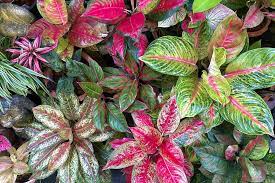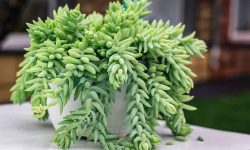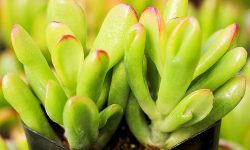I have been a houseplant enthusiast for five decades and Chinese evergreen plants are my favorite choice due to their ease of caring. Besides that, these plants can brighten your indoor space since they have vibrant leaves.
Learning how to care for Chinese evergreen plants isn’t that complex. But you need to create a controlled environment to ensure healthy growth and well-being. We wrote this Aglaonema care guide to help those having challenges.

Overview of Chinese Evergreen Care
Origin |
Tropical forests in Asia and New Guinea |
Scientific Name |
Aglaonema spp |
Common Names |
Chinese evergreen and Philippine evergreen |
Maximum Growth |
1-3ft |
Light Requirement |
Bright indirect sunlight. Bright direct sunlight could scorch the leaves. |
Watering Needs |
Moderate watering to keep the soil moist. Avoid a soggy environment since it will cause root rot |
Temperature Requirement |
70-75oF |
Soil Requirement |
Peat-based potting mix |
Humidity Level |
Above 40% |
Fertilizer Application |
Feed the plant twice during the growing season with slow-release liquid fertilizer |
Propagation |
Stem cuttings |
Re-potting |
Once every two years due to root-bound |
Pruning and Maintenance |
Remove the inconspicuous flowers and old leaves. |
Chinese evergreen Flowers |
Inconspicuous flowers |
Pests and Diseases |
Pests: Aphids, mealybugs, scale, and spider mites. Diseases: Root-rot |
Toxicity |
Toxic to pets and toddlers |
Growth Rate |
Slow-growing |
USDA Zones |
10-12 |
How to Care for Chinese Evergreen
By understanding and implementing proper care techniques, you can help your Chinese evergreen thrive. Here are the techniques to consider:
Light Requirements
Chinese evergreen can adapt to a wide range of lighting conditions. But its growth and appearance are influenced by the amount of light it receives.
Bright indirect light is ideal for this plant. Insufficient light can result in leggy growth and reduced foliage coloration. Excessive direct sunlight can scorch the leaves.
Adjust the plant’s placement based on its response to light. Ensure it receives adequate brightness without being exposed to harsh rays.
Watering Requirements
Proper watering is crucial for Chinese evergreen health. Overwatering can lead to root rot, while underwatering can cause the leaves to wilt and brown.
The watering frequency depends on various factors such as temperature, humidity, and soil type. It is best to allow the top inch of the soil to dry out between watering.
Before watering, check the moisture level by inserting your finger into the soil. If it feels dry, water the plant thoroughly and allow any excess water to drain away.
Temperature Range
Chinese evergreen prefers temperatures between 60°F (15°C) and 85°F (29°C). It can tolerate slightly lower or higher temperatures but is sensitive to extreme fluctuations.
Avoid placing the plant near drafts, air conditioning vents, or heat sources. Sudden temperature changes can lead to leaf yellowing and dropping.
Maintaining a stable temperature within the recommended range will promote optimal growth and keep the plant healthy.
Soil Requirements
A well-draining and fertile soil mix is essential for Chinese evergreen. Use a high-quality potting mix that retains some moisture while allowing excess water to drain away.
A mix of peat moss, perlite, and vermiculite or coconut coir provides good aeration and moisture retention. Avoid heavy clay-based soils that can retain too much water and cause root rot.
Humidity Level
Chinese evergreens appreciate moderate to high humidity levels. If the air in your home is dry, consider increasing humidity around the plant.
You can do this by placing the pot on a tray filled with pebbles and water or by using a humidifier. Misting the leaves occasionally can also help create a more humid environment.
Adequate humidity prevents leaf browning and encourages lush growth. Ensure your Chinese evergreen is placed in a well-ventilated space.
Fertilizer Application
Regular fertilization promotes healthy growth in Chinese evergreens. Use a balanced, water-soluble fertilizer formulated for houseplants.
During the growing season (spring and summer), feed the plant every two to four weeks. Dilute the fertilizer according to the instructions on the package and apply it to moist soil.
Reduce or eliminate fertilizer application during the winter months when the plant’s growth slows down. Be sure to flush the potting soil every three months to avoid salt accumulation.
Propagation
Chinese evergreen can be propagated through stem cuttings or division. To propagate through stem cuttings, select a healthy stem and cut it just below a leaf node.
Place the cutting in a container with water or a well-draining potting mix and keep it in a warm, humid environment. Roots will develop in a few weeks, and once the plant has established roots, you can transfer it to a pot.
Division involves separating the plant into smaller sections, each with roots attached. Ensure that each division has sufficient roots and foliage for successful growth.
Re-potting
Chinese evergreen typically needs to be re-potted every two to three years, or when the roots become crowded and start to circle the pot.
Choose a new pot that is one size larger and has drainage holes. Gently remove the plant from its current pot, loosen the root ball, and place it in the new pot.
Fill in with fresh potting mix, making sure the plant is at the same depth as before. Water thoroughly after re-potting to settle the soil.
Pruning and Maintenance
Regular pruning helps maintain the appearance and health of Chinese evergreens. Remove any yellowed, damaged, or dead leaves by cutting them off at the base.
Prune back leggy stems to encourage bushier growth. Keep the plant clean by wiping the leaves with a damp cloth or using a gentle spray of water.
Check for pests regularly and take appropriate measures if any infestation occurs. Be sure to prune your Chinese evergreen in spring.
Pests and Diseases
Chinese evergreen is relatively resistant to pests and diseases. But it can still be affected by common houseplant issues.
Mealybugs, spider mites, and scale insects can infest the plant. Inspect the leaves regularly for signs of pests and take action immediately if any are detected.
Wipe off pests with a cotton swab dipped in rubbing alcohol or treat the plant with an appropriate insecticidal soap. Avoid overwatering and ensure good air circulation to prevent fungal diseases.
Final Thoughts from Experts
Caring for the Chinese evergreen plant is a no-brainer task since it is easy to grow and maintain. We recommend following the above aglaonema care guidelines to enhance the beauty of your indoor space due to the plant’s vibrant foliage.
Different aglaonema varieties have the same care guidelines. Silver bay aglaonema is my favorite species due to its ease of growth and maintenance. Pink Aglaonema is another excellent choice for marking a bold statement in your indoor space.
People Who Read This Also Read:






